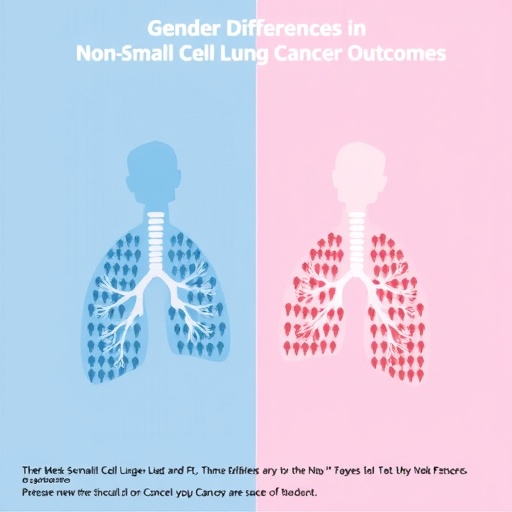Gender Differences in Non-Small Cell Lung Cancer Outcomes – Bioengineer.org

Report on Gender as a Prognostic Factor in Non-Small Cell Lung Cancer (NSCLC) and its Alignment with Sustainable Development Goals
Executive Summary
A 2025 study published in BMC Cancer establishes gender as a significant independent prognostic factor in Non-Small Cell Lung Cancer (NSCLC). The research, analyzing 715 patient cases, found that male patients have a notably poorer prognosis compared to female patients, particularly when receiving certain targeted therapies. These findings have profound implications for achieving key United Nations Sustainable Development Goals (SDGs), specifically SDG 3 (Good Health and Well-being), SDG 5 (Gender Equality), and SDG 10 (Reduced Inequalities). By highlighting gender-based disparities in health outcomes, the study underscores the need for gender-sensitive clinical research and personalized treatment protocols to ensure equitable and effective healthcare for all.
Introduction: Aligning Cancer Research with Sustainable Development Goals
Non-small cell lung cancer represents a major global health challenge, impeding progress towards SDG 3, which aims to reduce premature mortality from non-communicable diseases. This report analyzes a pivotal study that identifies gender-based survival disparities in NSCLC, directly addressing the principles of SDG 5 and SDG 10 by calling for the reduction of health inequalities.
The Global Burden of NSCLC and SDG 3
NSCLC is the most common form of lung cancer and is characterized by high mortality rates. The study’s focus on improving survival outcomes through stratified treatment directly supports Target 3.4 of SDG 3. Understanding differential treatment responses is critical to developing more effective therapeutic strategies and improving global health.
Addressing Health Disparities through SDG 5 and SDG 10
The research provides critical evidence of health outcome inequality based on gender. By investigating these disparities, the study contributes to the broader goal of achieving gender equality (SDG 5) and reducing inequalities within and among countries (SDG 10). The findings advocate for a healthcare system that acknowledges and adapts to biological differences between sexes to provide equitable care.
Study Methodology and Design
The investigation was conducted as a large-scale retrospective cohort analysis designed to isolate the variable of gender in NSCLC prognosis.
Cohort and Data Analysis
- Sample Size: Data was collected from 715 pathologically confirmed NSCLC cases over a six-year period.
- Methodology: Propensity score matching was employed to create comparable groups of male and female patients, minimizing confounding biases from other clinical characteristics.
- Objective: To ensure that observed differences in survival were attributable to gender-related factors rather than demographic or tumor heterogeneity.
Key Findings: Gender as a Critical Prognostic Factor
The analysis revealed statistically significant differences in survival outcomes between male and female patients across various treatment modalities.
Overall Survival Disparities
A stark contrast in overall survival was identified, underscoring a significant health inequality:
- Median Overall Survival (Male): 23 months
- Median Overall Survival (Female): 29 months
- Increased Mortality Risk for Men: Multivariate Cox regression analysis confirmed that male patients faced a 31% increased risk of mortality compared to female patients, independent of other factors like tumor stage.
Treatment-Specific Outcomes and Implications for SDG 3
The study dissected treatment responses, revealing that the efficacy of key anti-cancer therapies is gender-dependent. This insight is crucial for advancing personalized medicine under SDG 3.
- EGFR-TKI Therapy: Male patients receiving epidermal growth factor receptor tyrosine kinase inhibitors (EGFR-TKIs) exhibited a 49% higher mortality risk than their female counterparts.
- Immune Checkpoint Inhibitors: No significant gender-based survival disparity was observed in patients receiving immunotherapy, suggesting different biological interactions.
- Protective Therapies: Chemotherapy and anti-angiogenesis therapy were identified as protective interventions that reduced mortality risk.
Subgroup Analysis Highlighting Vulnerabilities
The gender disparity was more pronounced in specific patient subgroups, identifying populations requiring targeted clinical attention to fulfill the “leave no one behind” principle of the SDGs.
Male patients demonstrated significantly poorer prognoses under the following conditions:
- Early lymph node metastasis (N0-1)
- No distant metastasis (M0)
- Absence of brain metastases
- Post-surgical resection
Implications for Sustainable and Equitable Healthcare
The study’s conclusions call for a paradigm shift in oncology, integrating gender as a fundamental variable in clinical practice and research to build more resilient and equitable health systems.
Advancing Personalized Medicine (SDG 3)
To achieve good health for all, treatment must be personalized. This research demands that precision medicine evolve to incorporate intrinsic patient factors like gender alongside genomics. Revising standard protocols, especially for EGFR-TKI therapy in men, may be necessary to optimize outcomes.
Promoting Gender Equality in Clinical Research (SDG 5)
The findings highlight a critical gap in medical research. To ensure health interventions are effective for everyone, future clinical trials must be designed to validate gender-specific findings. This requires:
- Mandating gender as a predefined stratification factor in trial design.
- Ensuring adequate representation of both sexes in clinical studies.
- Analyzing and reporting results stratified by gender.
Fostering Partnerships for Innovation (SDG 17)
Addressing these complex gender disparities requires a multidisciplinary approach, aligning with SDG 17 (Partnerships for the Goals). Collaborative efforts between oncologists, molecular biologists, pharmacologists, and epidemiologists are essential to translate these clinical findings into new, gender-specific biomarkers and therapeutic targets.
Conclusion and Future Directives
This landmark study establishes gender as a clinically significant prognostic factor in NSCLC, paving the way for transformative advancements in cancer care that are more effective, equitable, and aligned with the Sustainable Development Goals. By illuminating how men and women respond differently to antitumor treatments, the research provides a clear mandate to develop gender-tailored therapeutic strategies. Future work must focus on validating these findings in prospective trials and unraveling the biological mechanisms—such as hormonal, genetic, or immunological differences—that drive these disparities. Ultimately, integrating gender into the core of oncology practice will enhance survival, improve quality of life, and ensure that progress in the fight against cancer benefits all patients equally.
Analysis of Sustainable Development Goals in the Article
1. Which SDGs are addressed or connected to the issues highlighted in the article?
-
SDG 3: Good Health and Well-being
The article is fundamentally centered on health, specifically on improving survival outcomes for non-small cell lung cancer (NSCLC), a major non-communicable disease. It discusses mortality rates, treatment effectiveness, and the need for personalized oncology, all of which are core components of ensuring healthy lives and promoting well-being.
-
SDG 5: Gender Equality
The study’s primary focus is on the disparities in health outcomes between men and women with NSCLC. By establishing gender as a “pivotal prognostic factor,” the article highlights a significant inequality in how the disease and its treatments affect different genders. It calls for research and clinical practices that address these gender-specific differences to ensure more equitable health outcomes.
2. What specific targets under those SDGs can be identified based on the article’s content?
-
Under SDG 3: Good Health and Well-being
-
Target 3.4: Reduce by one-third premature mortality from non-communicable diseases through prevention and treatment and promote mental health and well-being.
The article directly addresses this target by investigating the high mortality rate associated with NSCLC, a leading non-communicable disease. The research aims to improve treatment strategies (e.g., for EGFR-TKI therapy) to reduce mortality, as evidenced by the finding that “men faced a 31% increased risk of mortality relative to women,” and the study’s goal is to find ways to close this gap and improve overall survival.
-
-
Under SDG 5: Gender Equality
-
Target 5.c: Adopt and strengthen sound policies and enforceable legislation for the promotion of gender equality and the empowerment of all women and girls at all levels.
While this target is broad, the article’s call to action aligns with its principle of implementing policies that address gender-based disparities. The research advocates for policy-level changes in clinical practice and research, such as the need to “integrate gender as a critical variable when devising personalized treatment algorithms” and for future clinical trials to “incorporate gender as a predefined stratification factor.” This represents a move towards sound policies in healthcare that recognize and address gender differences to achieve equitable outcomes.
-
3. Are there any indicators mentioned or implied in the article that can be used to measure progress towards the identified targets?
-
For Target 3.4 (Reduce mortality from non-communicable diseases)
-
Indicator 3.4.1: Mortality rate attributed to cardiovascular disease, cancer, diabetes or chronic respiratory disease.
The article explicitly uses this indicator throughout its analysis. It measures and compares survival outcomes and mortality risks, stating that the “median overall survival in male patients was 23 months, notably shorter than 29 months observed in females” and that “men faced a 31% increased risk of mortality.” These statistics are direct measures of the mortality rate from cancer, which can be tracked over time to assess progress.
-
-
For Target 5.c (Adopt policies for gender equality)
-
Implied Indicator: Proportion of clinical trials and treatment protocols that include gender as a key stratification variable.
The article implies this indicator by criticizing current practices where clinical trials “often underrepresent or inadequately stratify by sex.” It advocates for a future where “gender-tailored treatment plans become standard practice.” Therefore, measuring the adoption of gender-stratified research designs and clinical guidelines would serve as a direct indicator of progress towards implementing policies that address the gender disparities highlighted in the study.
-
4. Summary Table of SDGs, Targets, and Indicators
| SDGs | Targets | Indicators |
|---|---|---|
| SDG 3: Good Health and Well-being | Target 3.4: Reduce by one-third premature mortality from non-communicable diseases through prevention and treatment. | Indicator 3.4.1: Mortality rate attributed to cancer. The article explicitly measures this through overall survival statistics (e.g., median survival of 23 months for men vs. 29 for women) and mortality risk (31% increased risk for men). |
| SDG 5: Gender Equality | Target 5.c: Adopt and strengthen sound policies for the promotion of gender equality. | Implied Indicator: Proportion of clinical trials and treatment protocols that include gender as a key stratification variable. The article calls for future studies to “incorporate gender as a predefined stratification factor” and for “gender-tailored treatment plans” to become standard practice. |
Source: bioengineer.org
What is Your Reaction?
 Like
0
Like
0
 Dislike
0
Dislike
0
 Love
0
Love
0
 Funny
0
Funny
0
 Angry
0
Angry
0
 Sad
0
Sad
0
 Wow
0
Wow
0



















































.jpg.webp?itok=0ZsAnae9#)



























